Projects
Coherent vortices using a dynamically consistent three-dimensional model of the ocean.
We extend recent work on elliptic transport barriers for unsteady three-dimensional flows to detect coherent vortices in the Agulhas leakage. We use the Southern State Ocean Estimate (SOSE) velocity field, which is a dynamically consistent model that assimilates physical measurements of temperature and salinity. The extracted barriers are sharp material boundaries for coherently evolving vortices that do not mix with their surroundings.
Participants : D. Blazevski
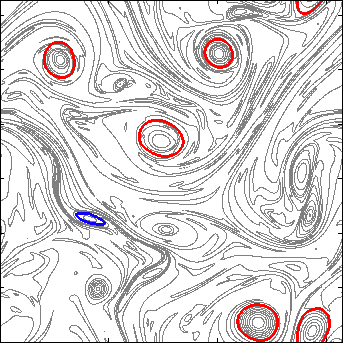 Lagrangian vortices
Lagrangian vortices
We conduct the first fully Lagrangian study of coherent vorticies in a direct numerical simulation of 2D Navier-Stokes turbulence. The coherent vortices (red) preserve their shape over a long period of time as opposed to a non-coherent vortex (blue). The gray curves show the instantaneous vorticity contours.
We find that Eulerian techniques, e.g. Okubo-Weiss criterion, all underestimate the extent of the coherent vortices.
Participants : M. Farazmand
Non-twist KAM tori
Numerical simulations have shown that non-twist KAM tori are the most robust tori under steady or time-periodic perturbations. Their counterparts in unsteady real-life flows are the cores of oceanic and atmospheric jets.
We develop a variational theory for extending the notion of non-twist tori from steady and time-periodic to general unsteady 2D flows. This theory results in an automatic detection algorithm for shearless (non-twist) jet cores.
Participants : M. Farazmand, D. Blazevski
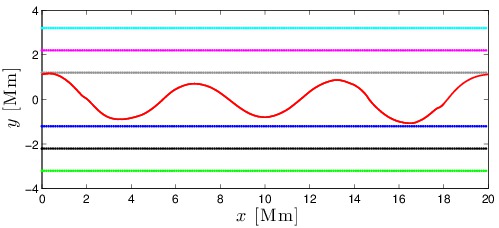
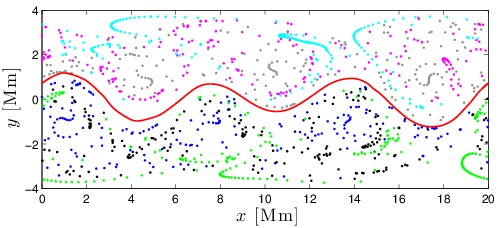
Transport barriers in planetary atmospheres
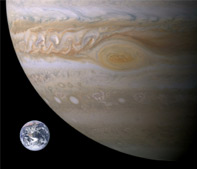 Jupiter is 1300 times the size of the Earth and more than twice the mass of all planets combined; yet, its atmosphere shares many similar features with Earth's atmosphere. Studying Jupiter's atmosphere gives us deep insight into atmospheric dynamics that could not be obtained by studying the Earth's alone.
Jupiter is 1300 times the size of the Earth and more than twice the mass of all planets combined; yet, its atmosphere shares many similar features with Earth's atmosphere. Studying Jupiter's atmosphere gives us deep insight into atmospheric dynamics that could not be obtained by studying the Earth's alone.
In this project, we utilize the concept of transport barriers and show how coherent vortices and jet streams affect mixing and transport in Jupiter's atmosphere.
Participants : A. Hadjighasem
Manifolds, attractors and KAM surfaces in aperiodic systems
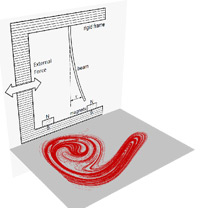 We show how the theory of geodesic transport barriers for fluid flows can be used to uncover key invariant manifolds in externally forced, one-degree-of-freedom mechanical systems. This approach enables the finite-time visualization of generalized stable and unstable manifolds, attractors and generalized KAM curves under arbitrary forcing, when Poincaré maps are not available. We illustrate these results by detailed visualizations of the key finite-time invariant sets of conservatively and dissipatively forced Duffing oscillators.
We show how the theory of geodesic transport barriers for fluid flows can be used to uncover key invariant manifolds in externally forced, one-degree-of-freedom mechanical systems. This approach enables the finite-time visualization of generalized stable and unstable manifolds, attractors and generalized KAM curves under arbitrary forcing, when Poincaré maps are not available. We illustrate these results by detailed visualizations of the key finite-time invariant sets of conservatively and dissipatively forced Duffing oscillators.
Participants : A. Hadjighasem
Transport by coherent eddies in the South Atlantic
The oceans are densely populated with mesoscale vortices with a typical diameter of 100km. It is still an open question to what extent these eddies carry a coherent volume of fluid and transport a well defined fluid volume along their path. The answer might also depend critically on the ocean region and the formation process of the eddies.
In this project, we focus on the Southern Atlantic Ocean where coherent eddies contribute to the inter-ocean exchange between the Indian and Atlantic Ocean, the Agulhas leakage. We use a recently developed method of Prof. Haller's group that allow to find the Lagrangian Coherent Structures (LCS) that define the outer boundaries of coherent eddies. These LCSs are closed orbits in the Lagrangian shear vector field that enclose the coherent fluid area.
We analyze a comprehensive 3D ocean data set, the Southern Ocean State Estimate (SOSE), with the objective to find all coherent eddies in an automated fashion and to quantify their contribution to transport of mass, heat and salinity.
Participants : F. Huhn
Theories of transport barriers in three dimensional flows
When trying to understand or even predict where material is transported to in oceanic flow, it has proven useful to employ solid mathematical tools for identifying key structures that act as invisible walls for particles inside the fluid. Being able to determine them promises to be very useful in event of an oil spill, or for the extension of climate models. Developing a geometrically appealing theory for these transport barriers in three dimensional flow with arbitrary time dependence is the focus of my ongoing work including their application to selected data sets.
Participants : D. Öttinger
Lagrangian Detection of Wind shear over Hong Kong International Airport
Wind shear is an aviation hazard as it may change the lift on the aircraft leading to instability. Real-time detection of low-altitude, shear inducing flow structures is, therefore, a major challenge in aviation safety.
 From spatially and temporally limited data sets of the measured velocity field near the Hong Kong International Airport (HKIA), we develop a method to identify Lagrangian coherent structures (LCS). LCS are distinguished frame-independent material structures that create localized attraction, repulsion, or high shear of nearby trajectories in the flow. As such, they are the fundamental skeletons behind airflow patterns such as updrafts, downdrafts, and wind shear.
From spatially and temporally limited data sets of the measured velocity field near the Hong Kong International Airport (HKIA), we develop a method to identify Lagrangian coherent structures (LCS). LCS are distinguished frame-independent material structures that create localized attraction, repulsion, or high shear of nearby trajectories in the flow. As such, they are the fundamental skeletons behind airflow patterns such as updrafts, downdrafts, and wind shear.
The aim of the project is the development of a robust and reliable algorithm to be used as an Alert system for landing aircrafts.
Participants : M. Serra

